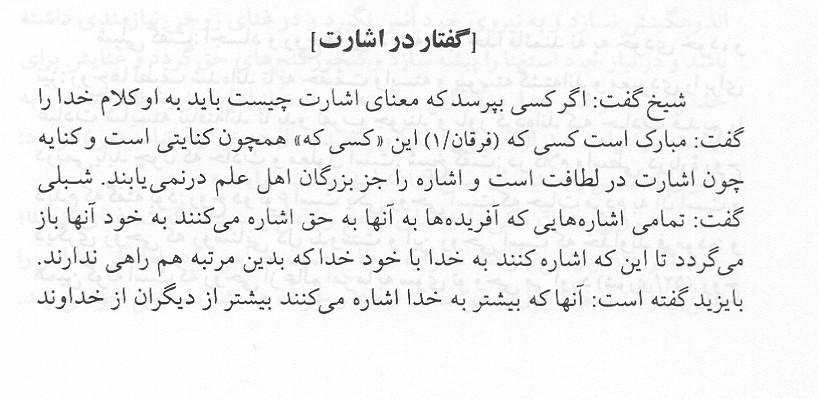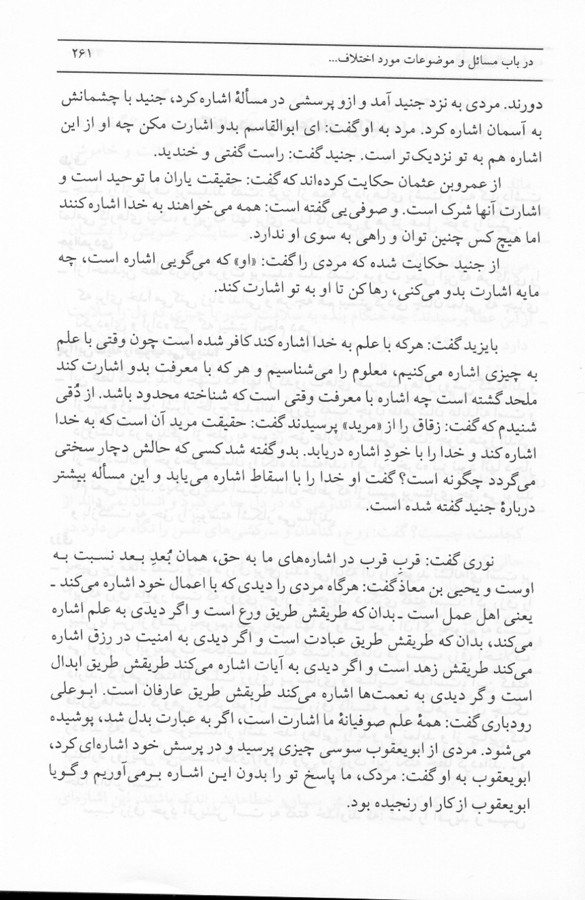
Glitter of
Sufism
Book 8, Section11
Ishārat (Pointing, Hinting)
Apercu
Discussion
Join
If someone asked what is the
meaning of Ishārat that person needs to be replied to with the Divine
Words, “Blessed is THAT WHICH…”
(Koran [25:1]) this manner of addressing (The Divine) is a form of
Ishārat (Pointing, Hinting) at something Latif (Indivisible, Subtle
& Non-material). (The term THAT WHICH or HE WHO or THAT or IT are
all (relative) pronouns pointing to what normally we call God or Lord.
However God or Lord are identifiers of the Sifāt (Divine Attributes)
hinting at Divine & Deification (Godhood) and the Master &
Sustainer (Lordship). Therefore the Arabic terms such as 'Hu' or
English IT are pointers without attempting to describe IT, hinting at
IT to show the way.)
And Ishārat (Pointing,
Hinting) is incomprehensible other than for the erudite. Shebly said,
“All creatures’ Ishārat (Pointing, Hinting) at the Haqq (True &
Absolute Reality, The Lord) bounces back to themselves unless they use
IT to point at IT and that is beyond the reach”.
Bā Yazid said, “Those who make
much Ishārat (Pointing, Hinting) at the Lord are furthest away from the
Lord”. (The act of Ishārat (Pointing, Hinting) at IT is a subtle act
deep within the human being. Therefore just making hints and pointing
at things does not make one closer to IT.)
A man once came to Jonaid and
asked a question about Ishārat (Pointing, Hinting). Jonaid replied by
rolling his eyes towards the sky. The man then said, “O Abul-Qasim
(Jonaid) do not make Ishārat (Pointing, Hinting) at IT since IT is
closer than this Ishārat (Pointing, Hinting) to you!” Jonaid said, “You
have said the truth” and then laughed. (This is how Jonaid taught the
man the art of Ishārat (Pointing, Hinting), this way the man using the
Jonaid’s rolling of the eyes understood that IT is beyond pointing
since IT is too close to the human being.)
People have narrated from the
‘Amro Ibn ‘Osmān, “The true nature of our people is Tawhid (Divine Oneness)
and their Ishārat (Pointing, Hinting) is Shirk (Polytheism)”. And some
Sufi said, “Everyone tries to Ishārat (Point, Hint) at the Lord but no
one has such power and way towards IT.”
Jonaid said to a man, “When
you say IT that is Ishārat (Pointing, Hinting), what substance/meaning
there is in this Ishārat (Pointing, Hinting)? (i.e. none) Therefore
forsake Ishārat (Pointing, Hinting) so IT will do Ishārat (Pointing,
Hinting) at you!”. (The Sufi learns how to position himself in his
heart so that he/she becomes the target-point for IT to point at. But
we have no control on IT, we can just do the best positioning and hope
and hope again.)
Bā Yazid has said, “Whomsoever
uses knowledge to make a Ishārat (Pointing, Hinting) at the Lord is a
Kafir (Disbeliever) since you can only point with knowledge when the
target is known & well understood and whomsoever uses Ma’refat
(Divine Gnosis) to make a Ishārat (Pointing, Hinting) he is Molhid (A
believer gone astray) since you can only point with Ma’refat (Gnosis)
when the target is partially known & understood”.
I heard from Doqqi quoting
Zaq-qāq about Morid (Seeker), “The true nature of the Morid (Seeker) is
via making Ishārat (Pointing, Hinting) at the Lord and being cognizant
of the Lord via Ishārat (Pointing, Hinting)”. And again was asked about
the Sufi who is in difficult state of Hāla (Momentary State
of the Heart) and he replied, “That person is cognizant of the Lord
via the failure of the Ishārat (Pointing, Hinting)!” and this was
mostly mentioned about Jonaid.
Nuri said, “The closest to the
Qurb (Divine Nearness) is our Ishārat (Pointing, Hinting) at the Haqq
(True & Absolute Reality, The Lord) and our furthest in Bu’d
(Divine Distance) is again the same Ishārat (Pointing, Hinting)”.
(Ishārat (Pointing, Hinting) is the acknowledgement of failure in all
forms of cognizance of the Divine and the humiliation of this failure
the vehicle that transports us closer to IT. Sometimes the enslavement
and humiliation of a lover—failure to understand & grasp—is the
transport that brings the blindfolded lover closer to his Beloved.)
Yahyā Bin Mo’āz said, “Any
time you see a person who makes Ishārat (Pointing, Hinting) by his
actions know that his Tariqat (Way) is piety and if you see someone who
makes Ishārat (Pointing, Hinting) by knowledge know that his Tariqat
(Way) is ‘Ibādah (Serfdom & Servitude) and if you see someone who
makes Ishārat (Pointing, Hinting) in being secure with provisions know
that his Tariqat (Way) is Zohd (Asceticism)
and if you someone who makes Ishārat (Pointing, Hinting) by wonders of
the nature know that his Tariqat (Way) is Faqr (Poverty) (Translation
?) forsaking this world and if you see someone who makes Ishārat
(Pointing, Hinting) by blessings know that his Tariqat (Way) is that of
‘Aref (Divine Cognoscente).” (He is talking about Ishārat (Pointing,
Hinting) being more than words or paradigms or bodily gestures.)
Abu Ali Rudbari said, “All our
Sufi knowledge is of the form Ishārat (Pointing, Hinting), if it is
explained by words then it is occluded.” (Concealed i.e. can not be
understood by explanations or phrases.)
End.
Apercu
Until the advent of Quantum
Mechanics due to excessive influence of Newtonian Mechanics, the
European philosophers were subjected to the static understanding of
scalar concepts:
“Also when we observe the
causal nexus, devoid of interplay with sense-presentation, the influx
of feeling with vague qualitative and ‘vector’ definition is what we
find. The dominance of the scalar physical quantity, inertia, in the
Newtonian physics obscured the recognition of the truth that all
fundamental physical quantities are vector and not scalar.” (“Process
& Reality”, Chapter Symbolic Reference, Section IV by Alfred North
Whitehead)
For example hand touching a
stone, is a scalar concept i.e. stone is there by itself in no relation
to the hand and the hand is there by itself in no relation to the stone
and when the two are too close there is a series of pulses (again all
scalar objects) traveling through our body to the brain and hence the
sensation/feeling of touch.
Thanks to Philosophies like
that of Alfred North Whitehead’s “Process & Reality” we have “gone
back” to our more primal ‘vector’ conceptualization. So the example of
the hand and the stone is explained as follows: Hand touching a stone
is a vector ‘feeling’ which is made up of the two vertices 1) Hand
being objectified by the stone 2) Stone being objectified by the touch
of the hand. Therefore there are no longer scalar & static concepts
like stone vs. hand, rather a vector composed of the hand and the stone
in relations to each other via objectification:
“Feelings are vectors; for
they feel what is ‘there’ and transform it to what is ‘here’.”
(“Process & Reality”, Chapter The Order of Nature, Section I by
Alfred North Whitehead)
In Sufism this vector
conceptualization is called Ishārat (Pointing, Hinting) is an essential
part of the Sufi knowledge and cognition, as was claimed by some the
entire Sufi knowledge is made up of the vector language of Ishārat
(Pointing, Hinting).
Jonaid made it clear in the
above text that the dipolar vector points from There (Azal:
Sempiternity) to Here: (Mohdath: Transient & Temporal) and not the
other way around. In other words something takes place in the Azal
(Sempiternity) that follows down the path of this vector to this
nascent & transient world. This vector becomes a feeling deep
within us and for extremely short period of time, when and if we can
capture the moment in few words we will be able to explain this
peculiar feeling. The language that describes these vector-feelings is
called the Ishārat (Pointing, Hinting).
As was noted or shall I say
prohibited by Bā Yazid the vector cannot point the other way around
i.e. from Here: (Mohdath: Transient & Temporal) to There (Azal:
Sempiternity)! Indeed if you attempt to describe such vector you will
send your Self astray.
However, not being under human
control, there are such ‘given’ vectors that point from Here to There!
As was noted by Nasafi the entire universe including Mankind is a
signpost pointing to IT (Minor-Human
vs. Eminent-Human). For example, when we look at the immense DNA
structures within each cell of our bodies, we feel a vector pointing
from Here to There! Pointing from a human cell to that Beloved Creator.
So our Divine Beloved left
clues and signs in form of vectors to point at IT in another universe
in order for Lovers to find their way. But note that these vectors are
not under our control and not an implant of ours. They are ‘given’, we
can find them but they are there but not on any account of our doings.
This art of Ishārat (Pointing,
Hinting) in verbal form was practiced by the Prophet peace be upon him
since the Arab was quite used to the usage of paradigms in poetry &
prose. For example, loosely translated, “Hearts are between the fingers
of Allah” is an example of usage of the Ishārat (Paradism, Hint) by the
prophet. Within the Koran itself many of the descriptions of Paradise
and other eternal entities are all indeed Ishārat (Paradigm, Hinting).
For example the wine we know in this world is a hint towards that wine
in the Azal (Sempiternity). Therefore the word wine in Koran’s Paradise
is not anything related to this wine in this world, rather the wine
here is a pointer (a paradigm) to something in the other world that may
resemble the wine here.
© 2003-2002,
Dara O. Shayda






